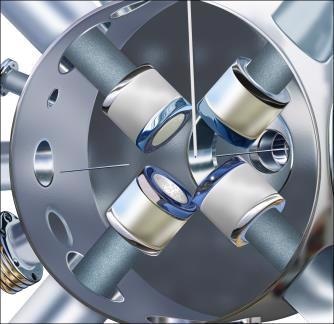The Optimized Wire Treatment (OWIT) project focuses on the development and validation of a new deposition technique enabling uniform coatings with superior physical properties on fibers and wires.
There are serious disadvantages with regards to conventional sputtering that use point sources or planar targets as it is not possible to provide the majority of sputtered species to the substrate.
In this article, a magnetron sputter system (Figure 1) has been proposed that operates in High Power Impulse (HIPIMS) mode, which preserves a great deal of metal ions. There is no loss of ions at the chamber walls and they can be repeatedly used for deposition, maintaining a high self-sputtering level even at relatively low power inputs.
Novel coatings with distinct chemical, physical and electrical properties can be obtained with excellent mechanical strength, long mechanical and chemical lifetimes and high ageing quality.

Figure 1. The experimental setup with four essentially balanced planar magnetrons (2" Ti targets), Langmuir probe, and the system of capillaries used to introduce wires from atmospheric pressure.
Objectives of New Deposition Technique
For verifying and evaluating the new method and the deposition technique, these key objectives were considered:
- Plasma modelling with Monte Carlo and particle-in-cell (PIC) techniques was performed using experimental data obtained with plasma diagnostic tools. For obtaining the optimum properties such as density, geometry and field distribution of the bulk plasma, extensive plasma modeling and computations were performed.
- In the area of smart processing of wires, a new technological level was achieved. The key problem and the originality of this project lies in concentrating high-density plasma in a small cylindrical volume having relatively large length. The objective is to create the right plasma shield surrounding the wires for implanting and depositing the constitutive species of coatings simultaneously.
This novel plasma configuration implies increased deposition rates and high treatment speeds. In the future, special attention will be paid to achieving ideal cylindrical plasma geometry for guaranteeing homogenous treatment all over the surface of the wire.
- Plasma diagnostics using the Hiden Analytical ESPion Advanced Langmuir Probe was carried out. For a range of power modes, the discharge was analyzed during the active phase of the HIPIMS plasma generation when the probe was in the center of the discharge volume between four balanced magnetrons.
When the cycle includes over one pulse, the triggering waveform was converted to a single pulse with a counting device. 5µs prior to achieving the first edge level of the discharge voltage at the start of every cycle, triggering was initiated. In this kind of configuration, the probe can provide 125ns resolution for key plasma parameters such as electron and ion densities, plasma and floating potentials.

This information has been sourced, reviewed and adapted from materials provided by Hiden Analytical.
For more information on this source, please visit Hiden Analytical.